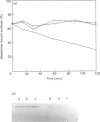Abstract
Hyaluronate synthase was shed into the culture medium from growing streptococci (group C) together with nascent hyaluronate. The mechanism of solubilization was analysed using isolated protoplast membranes. Solubilization increased when membranes were suspended in larger volumes, but it was temperature-independent and was not inhibited by protease inhibitors. Increased hyaluronate chain length enhanced solubilization. The soluble synthase could re-integrate into Streptococcal membranes in a saturable manner. The soluble synthase behaved like an integral membrane protein, although it was not integrated into phospholipid vesicles. In sucrose velocity centrifugation the synthase had a higher sedimentation rate in detergent-free solution, indicating that it existed in an aggregated state.
Full text
PDF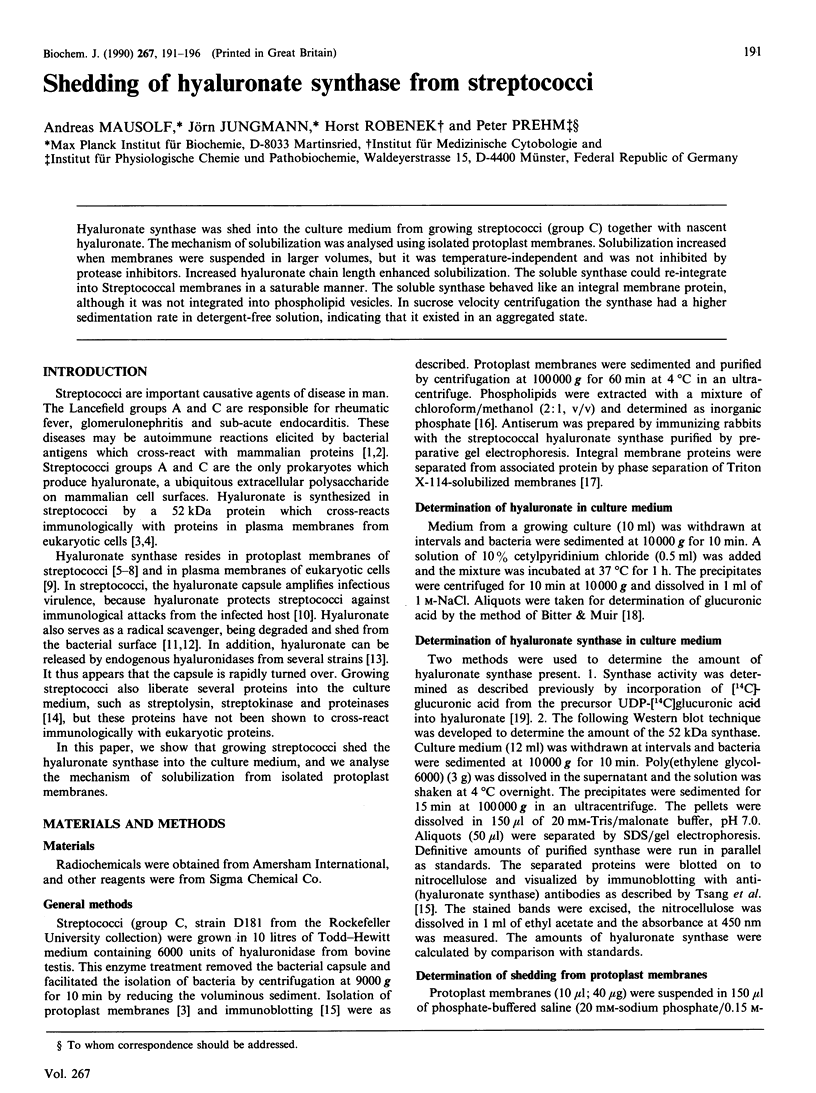
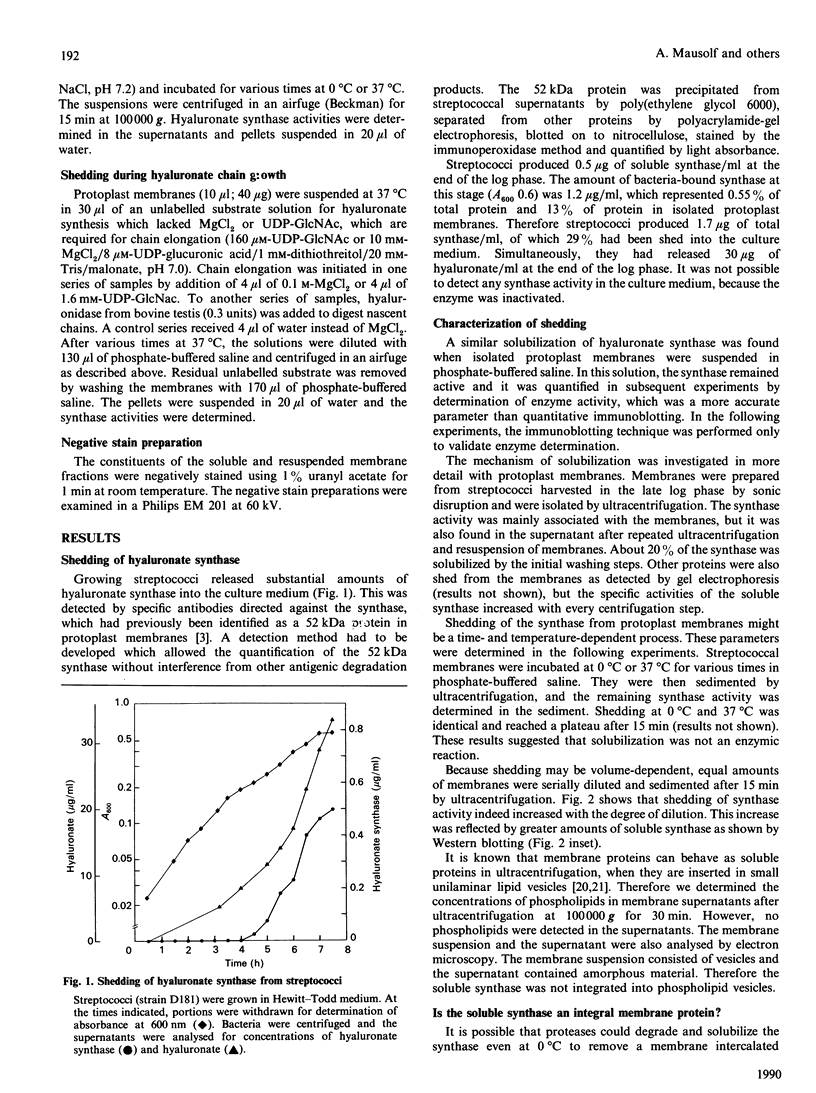
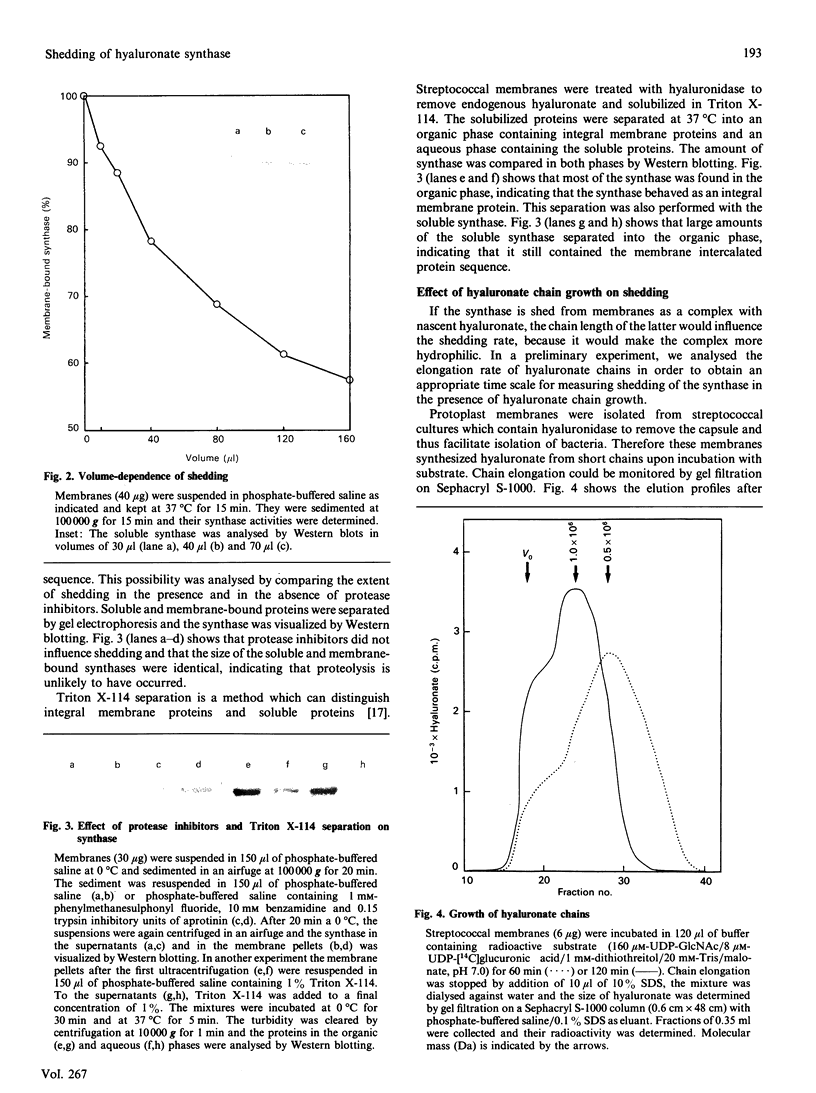


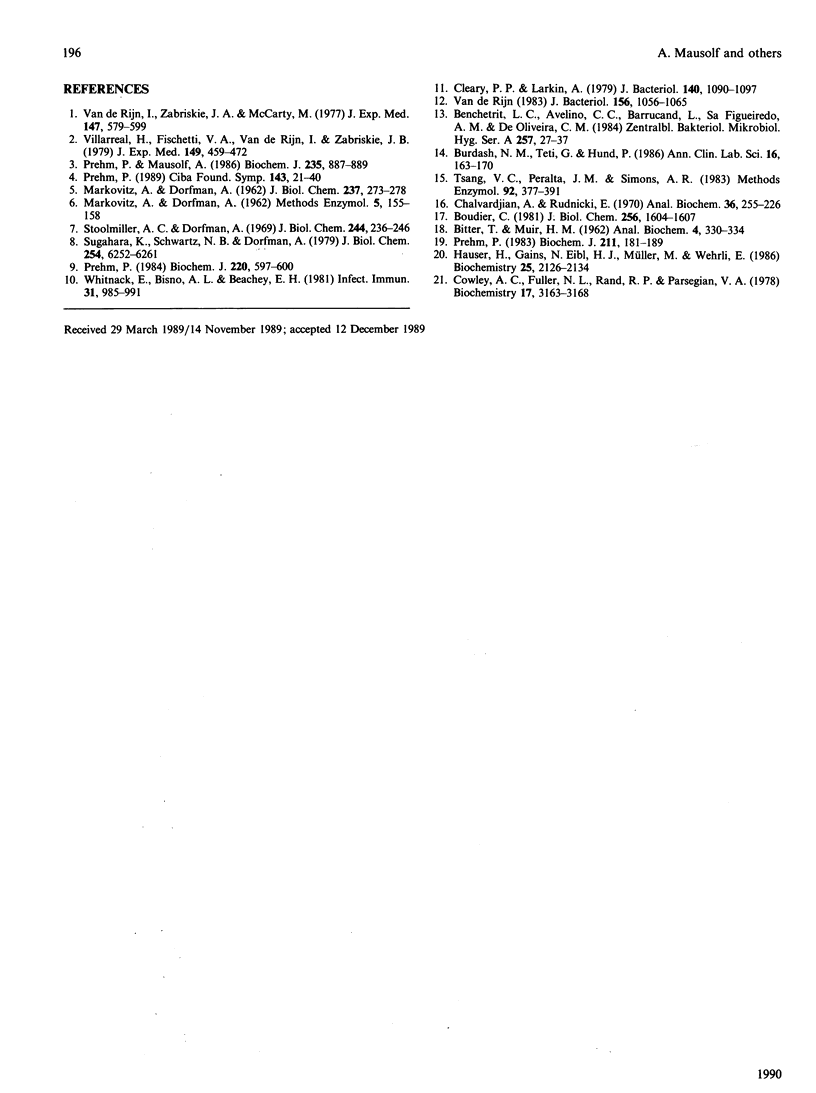
Images in this article
Selected References
These references are in PubMed. This may not be the complete list of references from this article.
- BITTER T., MUIR H. M. A modified uronic acid carbazole reaction. Anal Biochem. 1962 Oct;4:330–334. doi: 10.1016/0003-2697(62)90095-7. [DOI] [PubMed] [Google Scholar]
- Benchetrit L. C., Avelino C. C., Barrucand L., Sá Figueiredo A. M., de Oliveira C. M. Hyaluronidase production by groups A, B, C, and G streptococci: a statistical analysis. Zentralbl Bakteriol Mikrobiol Hyg A. 1984 May;257(1):27–37. [PubMed] [Google Scholar]
- Bordier C. Phase separation of integral membrane proteins in Triton X-114 solution. J Biol Chem. 1981 Feb 25;256(4):1604–1607. [PubMed] [Google Scholar]
- Burdash N. M., Teti G., Hund P. Streptococcal antibody tests in rheumatic fever. Ann Clin Lab Sci. 1986 Mar-Apr;16(2):163–170. [PubMed] [Google Scholar]
- Chalvardjian A., Rudnicki E. Determination of lipid phosphorus in the nanomolar range. Anal Biochem. 1970 Jul;36(1):225–226. doi: 10.1016/0003-2697(70)90352-0. [DOI] [PubMed] [Google Scholar]
- Cleary P. P., Larkin A. Hyaluronic acid capsule: strategy for oxygen resistance in group A streptococci. J Bacteriol. 1979 Dec;140(3):1090–1097. doi: 10.1128/jb.140.3.1090-1097.1979. [DOI] [PMC free article] [PubMed] [Google Scholar]
- Cowley A. C., Fuller N. L., Rand R. P., Parsegian V. A. Measurement of repulsive forces between charged phospholipid bilayers. Biochemistry. 1978 Jul 25;17(15):3163–3168. doi: 10.1021/bi00608a034. [DOI] [PubMed] [Google Scholar]
- Hauser H., Gains N., Eibl H. J., Müller M., Wehrli E. Spontaneous vesiculation of aqueous lipid dispersions. Biochemistry. 1986 Apr 22;25(8):2126–2134. doi: 10.1021/bi00356a042. [DOI] [PubMed] [Google Scholar]
- MARKOVITZ A., DORFMAN A. Synthesis of capsular polysaccharide (hyaluronic acid) by protoplastmembrane preparations of group A Streptococcus. J Biol Chem. 1962 Feb;237:273–279. [PubMed] [Google Scholar]
- Prehm P. Hyaluronate is synthesized at plasma membranes. Biochem J. 1984 Jun 1;220(2):597–600. doi: 10.1042/bj2200597. [DOI] [PMC free article] [PubMed] [Google Scholar]
- Prehm P. Identification and regulation of the eukaryotic hyaluronate synthase. Ciba Found Symp. 1989;143:21-30; discussion 30-40, 281-5. doi: 10.1002/9780470513774.ch3. [DOI] [PubMed] [Google Scholar]
- Prehm P., Mausolf A. Isolation of streptococcal hyaluronate synthase. Biochem J. 1986 May 1;235(3):887–889. doi: 10.1042/bj2350887. [DOI] [PMC free article] [PubMed] [Google Scholar]
- Prehm P. Synthesis of hyaluronate in differentiated teratocarcinoma cells. Characterization of the synthase. Biochem J. 1983 Apr 1;211(1):181–189. doi: 10.1042/bj2110181. [DOI] [PMC free article] [PubMed] [Google Scholar]
- Stoolmiller A. C., Dorfman A. The biosynthesis of hyaluronic acid by Streptococcus. J Biol Chem. 1969 Jan 25;244(2):236–246. [PubMed] [Google Scholar]
- Sugahara K., Schwartz N. B., Dorfman A. Biosynthesis of hyaluronic acid by Streptococcus. J Biol Chem. 1979 Jul 25;254(14):6252–6261. [PubMed] [Google Scholar]
- Tsang V. C., Peralta J. M., Simons A. R. Enzyme-linked immunoelectrotransfer blot techniques (EITB) for studying the specificities of antigens and antibodies separated by gel electrophoresis. Methods Enzymol. 1983;92:377–391. doi: 10.1016/0076-6879(83)92032-3. [DOI] [PubMed] [Google Scholar]
- Villarreal H., Jr, Fischetti V. A., van de Rijn I., Zabriskie J. B. The occurrence of a protein in the extracellular products of streptococci isolated from patients with acute glomerulonephritis. J Exp Med. 1979 Feb 1;149(2):459–472. doi: 10.1084/jem.149.2.459. [DOI] [PMC free article] [PubMed] [Google Scholar]
- Whitnack E., Bisno A. L., Beachey E. H. Hyaluronate capsule prevents attachment of group A streptococci to mouse peritoneal macrophages. Infect Immun. 1981 Mar;31(3):985–991. doi: 10.1128/iai.31.3.985-991.1981. [DOI] [PMC free article] [PubMed] [Google Scholar]
- van de Rijn I. Streptococcal hyaluronic acid: proposed mechanisms of degradation and loss of synthesis during stationary phase. J Bacteriol. 1983 Dec;156(3):1059–1065. doi: 10.1128/jb.156.3.1059-1065.1983. [DOI] [PMC free article] [PubMed] [Google Scholar]
- van de Rijn I., Zabriskie J. B., McCarty M. Group A streptococcal antigens cross-reactive with myocardium. Purification of heart-reactive antibody and isolation and characterization of the streptococcal antigen. J Exp Med. 1977 Aug 1;146(2):579–599. doi: 10.1084/jem.146.2.579. [DOI] [PMC free article] [PubMed] [Google Scholar]





